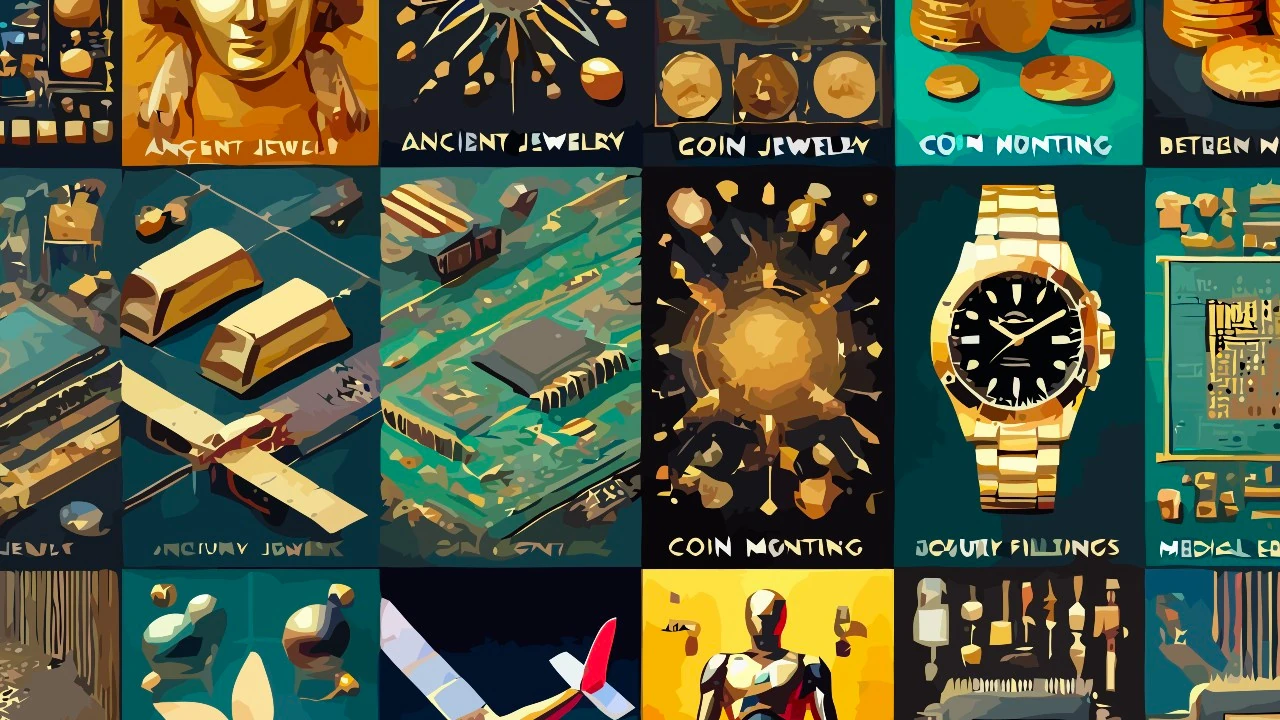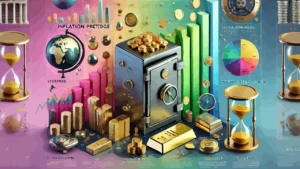Gold, a symbol of wealth and prestige, has spanned millennia, maintaining a central role in many sectors. It is not only one of the most sought-after precious metals in the world, but also one of the most versatile, thanks to its unique characteristics.
In this article, we will explore how gold is used, breaking down its uses into percentages and analyzing each area of application.
Contents
- Jewelry sector (50-55%)
- Investment sector (30-35%)
- Electronics sector (7-10%)
- Medicine and dentistry sector (2-3%)
- Industry and technology sector (1-2%)
- Art and objects sector (<1%)
#1. Jewelry sector
Usage percentage: 50-55%
The jewelry industry is the primary use of gold, a precious metal that has fascinated humanity for centuries. Prized for its durability and timeless beauty, gold is crafted into rings , bracelets, necklaces, and a wide range of luxury accessories. Its ability to resist oxidation and corrosion makes it ideal for creating jewelry that retains its luster even after many years. This aspect distinguishes it from other materials used in jewelry.
In addition to its resistance, gold is known for being easy to work with, a feature that allows master goldsmiths to create detailed and highly valuable creations. Manual processing and the use of modern technologies allow the production of unique pieces, which stand out for their high quality and sophisticated design.
The demand for gold jewelry varies significantly globally, reflecting different cultural traditions and style preferences. In India, for example, gold is a symbol of prosperity and a very important status symbol. During weddings, large quantities of gold are purchased in the form of jewelry to adorn the bride, reinforcing the link between culture and tradition. In the Middle East and Asia, however, gold is often seen as a form of personal investment, as well as a luxury good.
In Western markets, demand for gold jewelry is mostly influenced by fashion trends and seasons. Minimalist designs are currently popular, although preferences can vary greatly depending on the audience and budget.
Another crucial aspect is the gold content in the jewelry. Alloys such as 18-karat or 14-karat gold are widely used, as they offer greater resistance than pure gold, while maintaining an elegant appearance. This combination of resistance and beauty ensures that the jewelry will last a long time, making it suitable for everyday use.
Finally, modern technologies, such as 3D printing, are opening up new possibilities for jewelry designers. These innovative tools allow for the creation of shapes and details that would have been difficult to achieve in the past, pushing the boundaries of creativity and jewelry art ever further.
#2. Investment sector
Usage percentage: 30-35%
Gold is known as a safe haven, a valuable asset that people turn to in times of economic or political uncertainty. Its tangible nature and intrinsic value make it a particularly reliable and stable investment. It is especially popular during periods of inflation or financial crises, when other forms of investment may be riskier or more uncertain. Investments in gold take many forms, such as bars, coins, and exchange-traded funds ( ETFs ) that track the market price of the precious metal.
Central banks around the world play a central role in managing gold reserves. Countries such as the United States, Germany and Italy hold huge amounts of gold, which they use to ensure the stability of their currencies and economies. This accumulation is considered a strategic reserve, capable of acting as collateral in international markets and supporting investor confidence.
Among the most popular forms of investment are gold coins , such as South African Krugerrands, Canadian Maple Leafs, and American Eagles. These coins not only represent value based on their pure gold content, but also have aesthetic and sometimes collectible value. For many investors, gold coins offer a unique opportunity to combine beauty with financial return.
Even private individuals can benefit from buying gold. Small amounts of gold, in the form of bars or coins, are often purchased to diversify savings and protect against potential financial instability. With the advent of digital platforms, buying and selling gold has become simple, safe and accessible to a wider audience of people.
However, it is essential to consider the storage and insurance costs associated with storing physical gold. These aspects can significantly impact the overall return, making it necessary to carefully evaluate before proceeding with the investment. Despite this, gold remains a valid and attractive choice for protecting wealth over time.
#3. Electronics sector
Usage percentage: 7-10%
Electronics is one of the most innovative and growing sectors in terms of the use of gold. This metal, thanks to its unique properties, plays a fundamental role in ensuring high performance in modern devices. Among these properties are its excellent electrical conductivity and its resistance to corrosion, characteristics that make it indispensable for the functioning of smartphones, computers, televisions, electric vehicles and advanced medical devices. Although gold is often used in small quantities, its importance cannot be underestimated.
A common application of gold in electronics is found in connectors and printed circuit boards. The ability of this metal to transmit electrical signals without interference is essential to ensure the quality and reliability of electronic devices. For example, gold-plated connectors found in HDMI or USB cables offer superior data transmission compared to those made of less valuable materials. This quality makes them preferred in many technological fields.
Another significant sector is that of semiconductors. During the chip manufacturing process , gold is used to improve both the energy efficiency and the durability of electronic components. In addition, this metal is often used in optical sensor coatings and optical fibers, essential tools for high-level industrial and scientific applications.
The growing demand for electronic devices has led many companies to invest in innovative technologies for recycling gold from electronic waste. This process, known as “urban mining”, represents a key solution to reduce the environmental impact associated with traditional mining. Furthermore, recycling allows to meet future demand for gold in a more sustainable way.
However, despite technological advances, gold recycling remains a significant challenge. The advanced technologies needed to separate the metal from e-waste are expensive and often complex to implement. As a result, this process still presents difficulties both economically and logistically, requiring further development to be made more accessible on a large scale.
#4. Medicine and dentistry sector
Usage percentage: 2-3%
In the healthcare sector, gold occupies a prominent place thanks to its biocompatible properties and its extraordinary versatility in medical and dental applications. One of its main qualities is its chemical inertness, which makes it perfectly safe to use in contact with the human body. In dentistry, for example, gold is widely used for the production of crowns, bridges and fillings, offering a combination of resistance and durability over time. In addition to functionality, these dental devices are also aesthetically appreciated, thanks to the natural brilliance of the metal.
In addition to its dental use, gold is widely used in medicine for therapeutic treatments. An interesting example is the treatment of some forms of rheumatoid arthritis, which can be alleviated with gold-based compounds, such as aurothiomalate, which can reduce joint inflammation. Although less widespread than other treatments, this use demonstrates the potential of gold in the pharmacological field.
Another area where gold plays an essential role is medical diagnostics. In advanced diagnostic tests, gold nanoparticles are used to improve the sensitivity and accuracy of tests. This is particularly evident in rapid tests for infectious diseases, where gold binds to specific proteins or molecules, allowing for the precise identification of pathogens or biomarkers.
Gold is also essential in cutting-edge medical equipment . Instruments such as electron microscopes , surgical lasers, and advanced imaging devices often use gold-coated components to ensure optimal performance. Because it effectively reflects light and heat, the metal helps improve the precision and reliability of these instruments, which are essential for complex procedures and medical research.
In conclusion, gold is not only an economically valuable material, but also an irreplaceable ally in promoting health and well-being. With the continuous progress of medical research, it is likely that the applications of this metal in the healthcare sector will further increase, opening up new opportunities to improve people’s lives.
#5. Industry and technology sector
Usage percentage: 1-2%
Although it represents a small percentage of global consumption, gold plays a crucial role in some niche industrial and technological applications. Thanks to its unique physical and chemical properties , such as high thermal and electrical conductivity, this metal is indispensable in many advanced sectors, where a resistant and high-performance material is required.
One of the most fascinating areas in which gold is used is aerospace. In spacecraft and satellites, thin gold films are applied to protect the equipment from solar radiation and to maintain a stable temperature. This type of coating is essential to ensure the correct functioning of the instruments, especially in extreme conditions where even small temperature fluctuations could compromise the most delicate operations.
Another significant area is the use of gold as a catalyst in specific industrial chemical reactions. For example, in fuel cells, small amounts of gold can increase the efficiency of chemical reactions, thus contributing to the development of more sustainable technologies. This use also extends to the production of high-precision chemicals, where the reliability and stability of gold are essential characteristics to ensure quality results.
The glass and mirror industry also uses gold to create highly reflective coatings. Gold-coated glass is used in buildings to improve thermal insulation and reduce energy consumption. In parallel, the same principle is used in the production of high-performance mirrors, used in telescopes and scientific laboratories, where extremely precise control of light is required.
Finally, gold is playing a leading role in emerging technologies, such as 3D printing of metal components and flexible electronics. These applications exploit the unique properties of gold to develop innovative technological solutions. Thanks to its versatility, gold continues to push the boundaries of research, paving the way for new discoveries that could revolutionize various industrial and scientific sectors.
#6. Art and objects sector
Usage percentage: <1%
Gold has played a fundamental role in the art and objects sector since ancient times. Its luster, resistance to corrosion and malleability have made it an ideal material for the creation of works of art and decorative artefacts. Since ancient Egypt, it was used to make funerary masks, jewellery, amulets and coverings for sacred statues.
In the Middle Ages, gold was used in the miniature and decoration of religious manuscripts, as well as in the backgrounds of Byzantine icons. Its use was not only aesthetic but also symbolic: it represented divine light, eternity and perfection. In churches and cathedrals, gold leaf was applied to altars, frames and ceilings, elevating the spiritual meaning of the environments.
During the Renaissance, the use of gold was further refined thanks to the development of painting and sculptural techniques. Artists used it to enhance particular details, embellish fabrics and create an effect of depth and luxury. Even in the Baroque and Rococo periods, gold abundantly decorated furniture, mirrors and frames.
In the world of objects, gold continues to be highly appreciated. Watches, pens, tableware and design accessories often include gold inserts or plating, both for the material value and for the elegance they confer. In some cases, edible gold is used, in the form of leaves or powder, to decorate luxury sweets and drinks.
Today, gold is also present in contemporary design, combined with modern materials to create sophisticated and exclusive objects. Although styles and techniques change, the charm of gold remains unchanged, continuing to combine functionality, beauty and prestige.











Leave a Reply